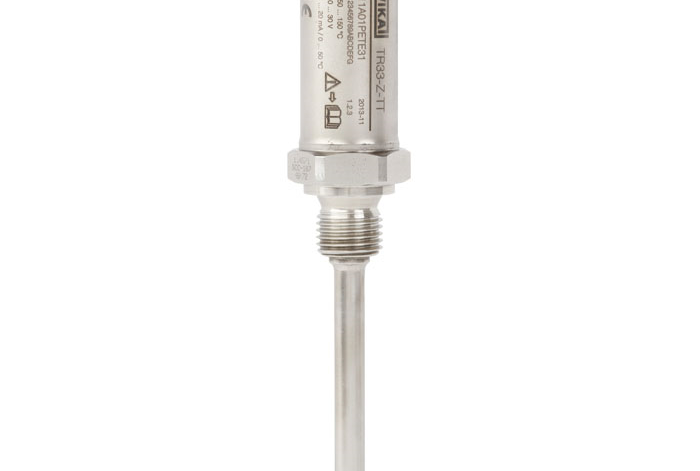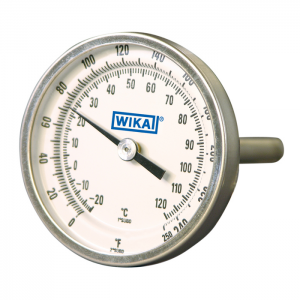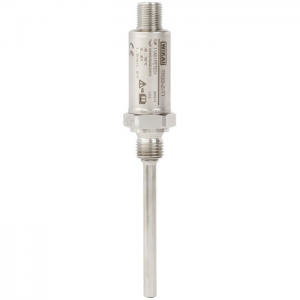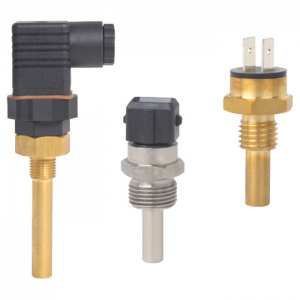
When designing mobile working machines, many engineers have difficulty understanding exactly which type of temperature measurement instrumentation to use. This confusion is usually because there are quite a few tradeoffs between each type of measurement technology.
The four major categories of temperature measurement include indicating, sensing, transmitting, and switching. Finding just the right measurement tool is the first step in the application process. The most basic form of temperature measurement for mobile working machines in indicating, which is rarely used today. Temperature indicating is synonymous with using a temperature gauge that works from a simple bimetallic spring. As the temperature on the machine increases, the bimetallic spring uncoils which then turns a pointer that indicates the temperature. The advantages of the temperature gauge, however, are low cost and simple indication, while the disadvantage is the gauge needs to be located at the point of measurement. In most situations this is impractical because the operator would have to stop the machine, and then physically move to the point of indication to read the temperature.
 The next type of temperature measurement for mobile working machines is sensing. In many cases, sensing uses an RTD or “resistive temperature detector” to measure the temperature by passing a current through the RTD and reading the change in resistance. In most cases the RTD is made from a pure metal like platinum or nickel with a known resistance to temperature relationship. The benefits of using an RTD to measure temperature are that it is relatively low cost, does not require a power source, very robust, and has a long life span. The downside is that the “signal” from the RTD is usually weak and can be subject to electromagnetic interference (EMI) or radio frequency interference (RFI), especially when the output wires are not properly shielded.
The next type of temperature measurement for mobile working machines is sensing. In many cases, sensing uses an RTD or “resistive temperature detector” to measure the temperature by passing a current through the RTD and reading the change in resistance. In most cases the RTD is made from a pure metal like platinum or nickel with a known resistance to temperature relationship. The benefits of using an RTD to measure temperature are that it is relatively low cost, does not require a power source, very robust, and has a long life span. The downside is that the “signal” from the RTD is usually weak and can be subject to electromagnetic interference (EMI) or radio frequency interference (RFI), especially when the output wires are not properly shielded.  Another temperature measurement alternative is transmitting which uses the same RTD signal as explained above. One thing to keep in mind about using transmitting temperature measurement is that the RTD also conditions and amplifies the signal so that it is less prone to EMI and RFI. The advantage of using a transmitter is that it can provide a predictable and strong ratiometric voltage or ratiometric current output signal. This output signal is easily processed by an onboard controller or computer. Unfortunately, the disadvantage is that the transmitter costs more than a simple RTD sensor, and the transmitter must to be powered by the machine in order to operate.
Another temperature measurement alternative is transmitting which uses the same RTD signal as explained above. One thing to keep in mind about using transmitting temperature measurement is that the RTD also conditions and amplifies the signal so that it is less prone to EMI and RFI. The advantage of using a transmitter is that it can provide a predictable and strong ratiometric voltage or ratiometric current output signal. This output signal is easily processed by an onboard controller or computer. Unfortunately, the disadvantage is that the transmitter costs more than a simple RTD sensor, and the transmitter must to be powered by the machine in order to operate.  The final major category of temperature measurement that is used on mobile working machines is temperature switching.
The final major category of temperature measurement that is used on mobile working machines is temperature switching.
Temperature switches use various switching technology, but the principle is the same. When a predetermined temperature is reached, a bellow or bimetal disc or, even a fluid, will expand and activate a mechanical micro switch. This mechanical micro switch can either open or close the circuit. Although different from the continuous signal of the sensor and transmitter, the temperature switch plays a crucial role in the machine’s operation by turning systems on or off when a particular temperature is achieved. The most notable machine operation is cooling systems which are activated when temperatures reach optimal design limits. The advantages of using a temperature switch include being cost efficient, rugged, not requiring a power source, and being user friendly. Conversely, the disadvantage is that the applications on mobile working machines are quite limited to only turning circuits on or off when a predetermined temperature is reached.  Of the many considerations to take into account, when selecting a temperature measurement for mobile working machines, it’s important to understand what action the measurement is to perform, and how the output signal will be processed to make that action a reality. Knowing the advantages versus the disadvantages of the different types of temperature measurement instrumentation will aid in the decision and possibly save time, money, and valuable resources where it matters most. As with other WIKA products, the temperature measurement instrumentation product line is supported worldwide by WIKA’s experienced and qualified staff. WIKA engineers are just a call (1-888-WIKA-USA) or an email (info@wika.com) away to provide guidance and help at all times.
Of the many considerations to take into account, when selecting a temperature measurement for mobile working machines, it’s important to understand what action the measurement is to perform, and how the output signal will be processed to make that action a reality. Knowing the advantages versus the disadvantages of the different types of temperature measurement instrumentation will aid in the decision and possibly save time, money, and valuable resources where it matters most. As with other WIKA products, the temperature measurement instrumentation product line is supported worldwide by WIKA’s experienced and qualified staff. WIKA engineers are just a call (1-888-WIKA-USA) or an email (info@wika.com) away to provide guidance and help at all times.

